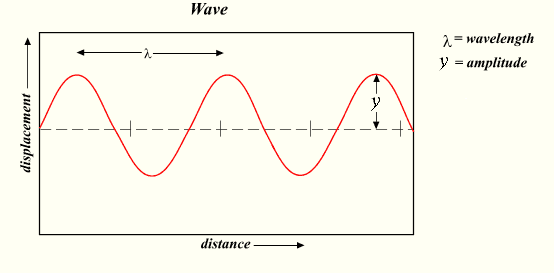Amplitude
|
|
- For the video game of the same name, see Amplitude (game).
Amplitude is a nonnegative scalar measure of a wave's magnitude of oscillation. In the following diagram,
the distance y is the amplitude of the wave. Sometimes that distance is called the "peak amplitude", distinguishing it from another concept of amplitude, used especially in electrical engineering: the root mean square amplitude, defined as the square root of the temporal mean of the square of the vertical distance of this graph from the horizontal axis. The use of peak amplitude is unambiguous for symmetric, periodic waves, like a sine wave, a square wave, or a triangular wave. For an unsymmetric wave, for example periodic pulses in one direction, the peak amplitude becomes ambiguous because the value obtained is different depending on whether the maximum positive signal is measured relative to the mean, the maximum negative signal is measured relative to the mean, or the maximum positive signal is measured relative the maximum negative signal and then divided by two. For complex waveforms, especially non-repeating signals like noise, the rms amplitude is usually used because it is unambiguous and because it has physical significance. For example, the power transmitted by an acoustic or electromagnetic wave or by an electrical signal is proportional to the square of the rms amplitude (and not, in general, to the square of the peak amplitude).
There are a few ways to formalize amplitude:
In the simple wave equation
<math>y = A \cdot \sin(t - K) + b<math>
A is the amplitude of the wave.
The amplitude of a wave is the measure of the magnitude of the maximum disturbance in the medium during one wave cycle, and is measured in units depending on the type of wave.
For waves on a string, the amplitude is a distance.
The amplitude of sound waves and audio signals conventionally refers to the amplitude of the air pressure in the wave, but sometimes the amplitude of the displacement (movements of the air or the diaphragm of a speaker) is described. Its logarithm is usually measured in dB, so a null amplitude corresponds to -inf dB.
For electromagnetic radiation, the amplitude corresponds to the electric field.
The amplitude may be constant (in which case the wave is a continuous wave) or may vary with time and/or position. The form of the variation of amplitude is called the Envelope detector of the wave.
Related topics
- Waves and their properties:
- Amplitude modulationda:Amplitude
de:Amplitude fr:Amplitude id:Amplitudo nl:Amplitude pl:Amplituda sl:amplituda sv:Amplitud ru:Амплитуда

